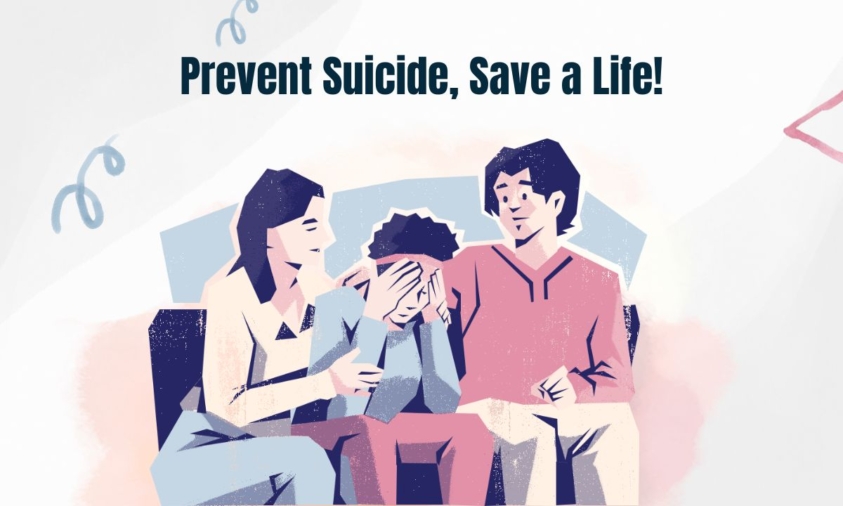What is Suicide?
Suicide is defined on the internet as the act of harming oneself with the wish to die. But human beings, equipped with survival instincts, are to protect themselves from death. The desire for death does not emerge like the desire to have one’s favourite dessert. Hence, it is not feasible to view it as a wish to cease one’s existence.
What is suicide, then? Despite people’s need to attach moral judgements (such as perceiving it as a sign of weakness, courage or attention seeking), it is not a topic of ethics. In simple terms— suicide is a symptom of pain. Like our bodies signal pain through body sensations, our minds signal psychological pain through negative thoughts. The mind of a person experiencing psychological pain of at level 10 tells the person, “No one cares for you, and you should kill yourself”.
Unless we connect suicide to pain, we cannot contribute to suicide prevention.
A Short Stepwise Guide to Save Lives
According to recent data, 80% of people show signs before they attempt suicide. If people learn to identify the warning signs and the appropriate responses to them, it can help save lives.
Here are some of the most evident warning signs of self-harm:
- Verbal signs: There can be direct or indirect clues. For instance, a person starts using words related to death frequently in their conversations. Or, they start making statements like, “what is the point of living?”
- Behavioural signs: There is a change in the person’s personality. For example, if they were extroverted and loud, they suddenly become silent and isolated. Some people also start showing “account-closing” behaviour, such as giving away their favourite possessions, paying off their long-forgotten debts, or discussing their will and insurance.
- Social media signs: A person may start posting their dark thoughts on their stories or WhatsApp status, share mentally disturbing posts, remove their display picture, or delete all their posts without explanation.
Navigate the sensitive conversation with the following steps:
Step 1: Acknowledge the pain
After you identify a warning sign, the first step is to acknowledge the pain.
Do: Assure them that you are coming from a place of care and ask them gently if they are feeling suicidal.
Example: “Hey, I have seen that people in your position often struggle with suicidal thoughts. It is completely okay if you have them. I’m concerned about you. Let me know if you’re struggling with negative thoughts— we can talk about it.”
Do not: Ask leading questions such as “You’re not suicidal, right?” or “You don’t want to kill yourself, right?” because this indicates that you want to hear them say no.
Step 2: Give them Space
Often people become defensive with such questions and try to deflect from having the conversation.
Do: Give them space within the conversation and let them know that you’re there for them and they can reach out to you later if they want.
Example: “It is okay if you don’t want to talk about it right now. I am here if you want to have this conversation later.”
Do not: Impose on them that they are suicidal and force them to open up.
Step 3: Be Open to Hearing “Yes”
Be prepared to hear them say “Yes, I am having suicidal thoughts.”
Do: Listen to them actively and encourage them to share their problems with you. Let them know that you understand that they are in pain and validate their feelings.
Example: “Although I cannot understand your situation, because I have never been through it, I can see that you are in a lot of pain.”
Do not: Interrupt with your own opinions about their situation and/or try to invalidate their feelings.
Step 4: Thank Them for Sharing and Redirect
It is important to acknowledge that it took a lot of courage on their end to share their pain with another person. However, if you feel that you’re not equipped to help them in the situation, you can offer to help them find the right professional.
Do: “Thank you for sharing. I understand it must have been difficult for you to come forward and share it. Since I am not professionally trained to help you in this situation, do you want me to connect you to someone who is?”
Do not: “You sound suicidal. You should see a therapist”
Conclusion
Small acts of kindness, care, and understanding can create ripple effects. They can make someone climb off the bridge. They can be the reason someone never knows the taste of poison. It can ensure that a kitchen knife only slits apples.
Suicide prevention is a transferrable life skill. It can be learned and then passed on to the next in line, like a universally accessible lifesaving tool.
– Authored by Ayush Bardhan, Trainee Associate, The Legal Swan


 Cart is empty
Cart is empty 
